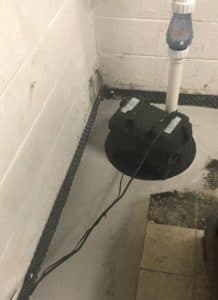
Originally posted 5/26/19; updated 7/2/20
The easiest way to tell if your sump pump is working is to note whether or not it’s removing excess water from your basement. Why, thank you, Captain Obvious! In all seriousness, there are times when it may still be working, but you’re not sure if it’s working efficiently. If the pump is not working at full capacity, you could be surprised with a flooded basement during a heavy rain.
Acculevel has been waterproofing basements and crawl spaces since our start in 1996. We are well-acquainted with the damage water can do to a home’s structure and stability, and we know you want to avoid those types of problems.
In this article, we’re going to give a brief overview of sump pumps and how they work. We’ll then walk you through some testing methods and suggest the best ways for you to keep your basement dry and stress-free.
Like most things you buy, all sump pumps are not created equal. They function in different ways, and vary in both cost and quality.
Water-powered pumps are not common here in the Midwest, because of this low capacity. Unexpected (we call them pop-up) thunderstorms are a regular occurrence, and they can produce large amounts of rain in a short period of time. If you are in the market for a new submersible pump, we have an article that ranks the top 5 sump pumps in 2020.
 This photo was taken by an Acculevel crew member, after water drainage and a sump pump were installed.
This photo was taken by an Acculevel crew member, after water drainage and a sump pump were installed.
Again, I’m going to play Captain Obvious and ask: “Is it plugged in?” Take that a step further and verify that the outlet itself is in good working order. Look over the power cord, and make sure it’s not frayed or damaged, and that it connects securely to the pump. Once you’ve verified the outlet is good, plug the pump back in and check to see if the power light is on.
Not sure the outlet is good? You may need to check your electric panel (or fuse box). If a breaker has been tripped or a fuse has been blown, this could be why the outlet has no power. If the power cord is plugged into a GFI outlet, these usually have a small indicator light in the center. If this is off, push the reset button (it should be next to the light) and this should correct the issue.
Your sump pump may have power and look fine, but if the float is damaged the pump may activate at the wrong time- or not at all. To test the pump, fill the basin to the water level that activates the pump. If the water empties out in a timely manner, you’re good to go.
If it doesn’t kick on or pump any water out, check to see if the float is broken or if it or the arm switch lacks room to move. Safety first: unplug the pump before you check any of the components.
Once you’ve verified the pump is in good working order, check the discharge line. If there is a clog or kink in the line, it will prevent the water from draining effectively. In cold weather, it could be ice in the line. We have an article that explains how to prevent sump pump hose freezing outside to help you address outdoor freezing issues and keep water flowing properly.
If all of these seem to be fine, but you are still getting excess water in your basement or crawl space? You may need to install a more powerful pump, or an additional pump.
Another item to consider is a battery back-up. Thunderstorms sometimes cause a power outage; a battery-operated pump can be a lifesaver in those instances. We strongly encourage all customers to have one; every sump pump we install comes with a battery back-up as a best practice.
We recommend that homeowners check their sump pump systems for efficiency twice a year. In fact, we’ve created a free DIY home inspection checklist for our readers to use. This preventative maintenance guide takes you through the process of checking your home’s foundation and surrounding area.
If you’ve gone through the troubleshooting process, and still have concerns about keeping your basement or crawl space dry, it may be time to contact a professional. Most contractors provide free estimates, and diagnosing a problem in the early stages can save you money and headaches later. Please find a qualified local contractor and verify that they are reputable, insured, and accredited by the Better Business Bureau.
Is this the first time you’ve needed a contractor? Or have you had bad experiences in the past? We have generated a list of questions that homeowners should ask a contractor, and offer a free download of this guide to anyone needing repairs to their home.
If you live in our coverage area, contact Acculevel. We provide free estimates without high-pressure sales tactics, and warranty our water drainage systems for the life of your structure. Contact us, and one of our friendly office staff will schedule an appointment for you with one of our experienced project managers.
[DISPLAY_ULTIMATE_SOCIAL_ICONS]